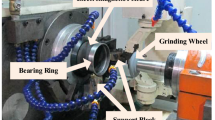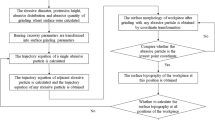Abstract
Bearing raceway grinding process has a large influence on the work quality and the rotate accuracy of the bearings. Surface roughness and heat affected layer, which have a strong relationship with grinding process quality, are important factors relevant to the bearing raceway surface quality. Based on the integrated grinding process model proposed previously by the author, which can calculate ground surface roughness, grinding forces, grinding temperature field, and dark layer thickness, from the investigation on the microscopic interaction mechanism between grinding wheel and workpiece surface in the grinding contact zone, the calculation results had been validated through a series of experiments which were conducted on the raceway grinding experimental platform. Based on the simulated and experimental results, both the surface quality and the process efficiency were taken as the optimize objectives, and the determination method on the process parameters was proposed. The optimized process parameters could not only avoid the dark layer occurrence, satisfying the technical requirement on the roughness, but also reached the highest process efficiency. The determination method and the optimized process parameter set could directly be used in the practical machining processes.
Similar content being viewed by others
References
Jurko J, Panda A, Valíček J, Harničárová M, Pandová I (2016) Study on cone roller bearing surface roughness improvement and the effect of surface roughness on tapered roller bearing service life. Int J Adv Manuf Tech 82:1099–1106
Yan K, Wang N, Zhai Q, Zhu Y, Zhang J, Niu Q (2015) Theoretical and experimental investigation on the thermal characteristics of double-row tapered roller bearings of high speed locomotive. Int J Heat Mass Tran 84:1119–1130
Yan K, Wang Y, Zhu Y, Hong J, Zhai Q (2016) Investigation on heat dissipation characteristic of ball bearing cage and inside cavity at ultra high rotation speed. Tribol Int 93:470–481
Chang Z, Jia Q, Yuan X, Chen Y (2017) Optimization of the grinding process to improve the surface integrity of bearing raceways. Int J Adv Manuf Tech. doi:10.1007/s00170-017-0061-3
Zhang K, Yu Y, Wang W, Li H (2015) Experimental study on internal cylindrical grinding of bearing steel with electrolytic in-process dressing grinding. Int J Adv Manuf Tech 81:1175–1185
Xu W, Wei Z, Sun J, Wei L, Yu Z (2012) Surface quality prediction and processing parameter determination in electrochemical mechanical polishing of bearing rollers. Int J Adv Manuf Tech 63:129–136
Wu MY, Gao H (2016) Experimental study on large size bearing ring raceways’ precision polishing with abrasive flowing machine (AFM) method. Int J Adv Manuf Tech 83:1927–1935
Hashimoto F, Gallego I, Oliveira JFG, Barrenetxea D, Takahashi M, Sakakibara K, Stalfelt HO, Staadt G, Ogawa K (2012) Advances in centerless grinding technology. CIRP Ann-Manuf Techn 61:747–770
Mamalis AG, Kundrak J, Manolakos DE (2003) Effect of the workpiece material on the heat affected zones during grinding: a numerical simulation. Int J Adv Manuf Tech 22:761–767
Li GF, Wang LS, Yang LB (2002) Multi-parameter optimization and control of the cylindrical grinding process. J Mater Process Technol 129:232–236
Rowe WB, Spraggett S, Gill R (1987) Improvement in cengerless grinding machine design. CIRP Ann-Manuf Techn 36:207–210
Chiu N, Malkin S (1993) Computer simulation for cylindrical plunge grinding. CIRP Ann-Manuf Techn 42:383–387
Xiao G, Malkin S (1996) On-line optimization for internal plunge grinding. CIRP Ann-Manuf Techn 45:287–292
Xiao G, Malkin S, Danai K (1993) Autonomous system for multi-stage cylindrical grinding. J Dyn Syst-T ASME 114:667–672
Jiang JL, Ge PQ, Hong J (2012) Study on micro-interacting mechanism modeling in grinding process and ground surface roughness prediction. Int J Adv Manuf Tech 67:1035–1052
Jiang JL, Ge PQ, Bi WB, Zhang L, Wang DX, Zhang Y (2013) 2D/3D ground surface topography modeling considering dressing and wear effects in grinding process. Int J Mach Tool Manu 74:29–40
Jiang JL, Ge PQ, Sun SF, Wang DX, Wang YL, Yang Y (2016) From the microscopic interaction mechanism to the grinding temperature field: an integrated modelling on the grinding process. Int J Mach Tool Manu 110:27–42
Hecker RL, Ramoneda IM, Liang SY (2003) Analysis of wheel topography and grit force for grinding process modeling. J Manuf Process 5:13–23
Merchant ME (1945) Mechanics of the metal cutting process. I. Orthogonal cutting and a type 2 Chip. J Appl Phys 16:267–275
Rowe WB (2001) Thermal analysis of high efficiency deep grinding. Int J Mach Tool Manu 41:1–19
Malkin S (1989) Grinding technology: theory and applications of machining with abrasives. Ellis Horwood, Chichester and Wiley, New York
Author information
Authors and Affiliations
Corresponding author
Rights and permissions
About this article
Cite this article
Jiang, J., Ge, P., Sun, S. et al. The theoretical and experimental research on the bearing inner ring raceway grinding process aiming to improve surface quality and process efficiency based on the integrated grinding process model. Int J Adv Manuf Technol 93, 747–765 (2017). https://doi.org/10.1007/s00170-017-0462-3
Received:
Accepted:
Published:
Issue Date:
DOI: https://doi.org/10.1007/s00170-017-0462-3




